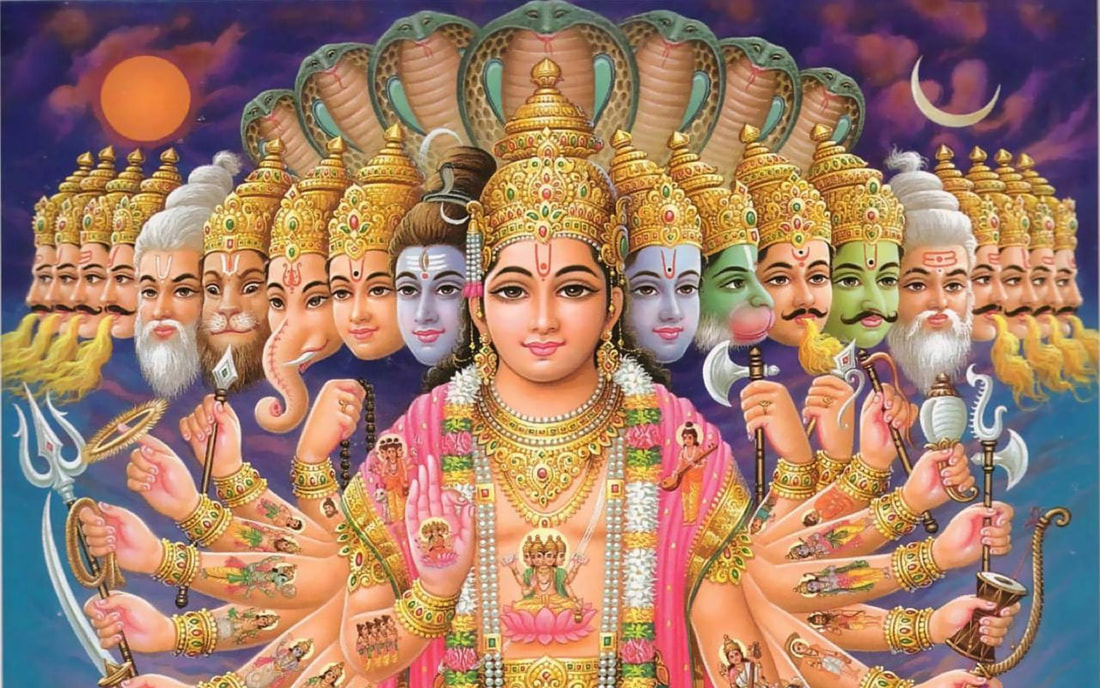|
Satchitananda
Satchitananda (Sanskrit: सच्चिदानन्द), a compound word of Sat (Existence), Chit (Consciousness), and Ananda (Bliss), is a description of the subjective experience of Brahman. This sublimely blissful experience of the boundless, pure consciousness is a glimpse of ultimate reality. Sat, Chit and Ananda are not three distinct entities. They are not different from one another. They are coeval and coexistent with Atman. Just as water, Jal & Pani and light, heat and luminosity signify one and the same thing, so also Sat-Chit-Ananda signifies the one Atman. What is Sat, Chit and Ananda:
Where Satchitananda explained: In Vedas & Upanishads: Sat or Truth:
One of the most important verses of the Rig Veda (1.164.46) is: The Reality (Truth) is ONE: the wise call It by various names. Ekam sat vipra bahudha vadanti. Ananda or Bliss:
In “Yoga and the Spiritual Life” Sri Chinmoynanada has stated - “To be sure, the Kingdom of Heaven is more than just a mere plane, like other planes. It is a plane of divine Consciousness. It is a state of Realisation. It embodies Sat-Chit-Ananda. Sat is divine Existence, Chit is divine Consciousness, Ananda is divine Bliss. When we go deep within, we feel these three together, and when we acquire the inner vision to perceive them all at once, we live verily in the Kingdom of Heaven. Otherwise, Existence is at one place, Consciousness is somewhere else and Bliss is nowhere near the other two. When we see and feel Existence-Consciousness-Bliss on the self-same plane, each complementing and fulfilling the others, we can say that we live in the Kingdom of Heaven. Yes, the Kingdom of Heaven is within us. Not only can we feel it, but without the least possible doubt, we can become it.” In Sri Aurobindo's evolutionary vision of the soul and the Universe, of which sachidananda is the principal term, even though the soul is incarnate in maya and subject to space, matter and time, it maintains an ongoing and eternal oneness with Saccidananda or divinity. This incarnating aspect or dimension of the human being, the spirit-soul, or the 'psychic being' or chaitya purusha, is the staple essence that reincarnates from life to life. This essence is of the energetic quality of sachidananda. Aurobindo holds that there exists a supreme power, the 'Supermind', which is the first emanation from sachidananda and can be brought into play through the practice of yoga to yoke life, mind and matter with sublime states of consciousness, being, delight and power and thereby manifest more of our inherent divinity. Where Satchitananda resides: Consciousness is multi-layered in human beings, which has potential to move upward. These layers are called in Hindu philosophy (Taittiriya Upanishad) as Pancha Kosha - starting from lowest, annamaya, pranamaya, manomaya, vijaynamaya and ananadamaya. It depends on the evolutionary stage of the person, he or she enjoys living in that particular level or realm. Satchitananda is highest plane.
The trained mind can influence the entire physical body system to function well and conserve energy. The trained mind increases concentration. The purified mind overcomes selfishness and ego, increases inner strength and brings inner peace. We can purify the Manomaya kosha through meditation, karma yoga (selfless service and charity work), bhakti yoga (prayer), knowledge (studying the scriptures), and Yama and Niyamas (the yogic moral ethics towards the society and self-discipline). The state of the manomay kosh is affected by both what we eat (annamaya kosha) and our energy level (pranamaya kosha) too. The person residing in this layer has thoughts and desires which identify with form and name, position and qualities. He is emotional in nature. This person lacks the cognitive abilities of reasoning and is void of any discrimination but may have keen appreciation for fine arts, music and dance and drama.
The person residing in Vigyanamaya Kosha is knowledgeable and wise. Loves literature, creative and are good orators. This fourth sheath is the wisdom that lies beneath the processing, thinking aspect of the mind. He knows, decides, judges, and discriminates between the information he processes and is innovative. Discovery, research and management are the areas where these people are involved in. Persons experiencing Anandamaya Kosha are stable in behaviour and firm in decision, are happy in every state of life and appreciate higher order of things and thinking like nature, prayers, meditation connection with God etc. They are self-realized persons.
In Shrimad Bhagavad Gita, Bhagwan Sri Krishna has explained the means to reach Satchitananda. Self-surrender (Smarpan) to almighty is only means to reach Satchitananda. He says:
0 Comments
Leave a Reply. |
Archives
March 2024
Categories
|

 RSS Feed
RSS Feed